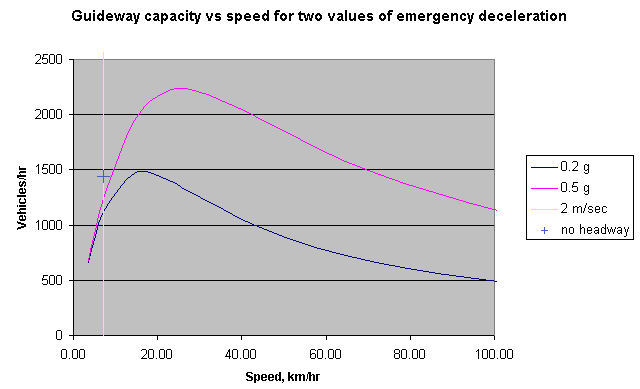The maximum number of PAT vehicles per hour for a single guideway:
| Maximum vehicles per hour | Speed for maximum throughput | |
| No headway | 1400; -used in models | 2 m/sec, 7.2 km/hr |
| 0.2 g emergency deceleration | 1450 | 4.5 m/sec, 16.1 km/hr |
| 0.5 g emergency deceleration | 2250 | 7.1 m/sec, 25.5 km/hr |
In the grand scheme of things this seems rather small.
| Estimated for 10 rail lines to East London Olympic Park stations | 320,000 | |
| London Crossrail: projected 24 trains p hr | 78000 | |
| Wembly Park Station can now accommodate... | 37500 | |
| National Rail into Charing Cross London | 33000 | |
| Bus lane in New York | 31000 | |
| Cabins on a conveyer belt, 1.2 passengers/cab, 40 km/hr | 20000 | |
| 10 section articulated vehicle (SSAV), 40 passengers, 120 km/hr | 17000 | |
| 20 Eurostar trains per hr, all 800 seats filled | 16000 | |
| Average air travel, UK to Europe | 7000 | |
| Max cars (2800/hr) on one lane of motorway, 1.2 passengers/car | 2800 | |
| Max PAT, 0.5g emergency breaking, 1.2 passengers/cab, 20 km/hr | 2600 | |
| Max PAT, 0.2g emergency breaking, 1.2 passengers/cab, 20 km/hr | 1700 | |
| One person every 3 seconds through turn-style | 1200 | |
| Taxi 2000, case study for Albuquerque, 2006. 702 Cabs/hr, 1.2 passengers/cab | 847 |
The ultimate capacity of the guideway feeding the station is set by minimum headway considerations. The figure shows the capacity of a guideway, limited by the "brick wall" criterion, depends on speed and maximum emergency deceleration. The lower value of deceleration of 0·2 g is the estimated maximum breaking effort that can be reliably achieved with rubber tyres on concrete for any weather condition. The higher level is probably the limit for not injuring passengers too much in what is expected to be a rare fault condition.

The yellow line represents the speed of the vehicles in the models, set at 2m/s, which is sufficiently low that headway can be neglected. (Note that this is about the same speed as fairground bumper-cars or Dodgems.) The maximum capacity of a station with this speed, vehicles at 5m intervals and ignoring headway limits, is indicated by the blue cross.
Note that the station here is defined as a number of berths at which passengers board and alight. These will be connected by a network of branched tracks with an upper speed limit of around 2m/s to a single entrance and a single exit. These will link to the network via deceleration/acceleration sections.
Higher guideway capacity can be obtained by more effective breaking. As shown by the upper curve, a 0·5 g breaking effort allows a capacity comfortably greater than station capacity.
It can be seen that there is an optimum speed for which the capacity of the guideway is maximum. For the lower maximum deceleration, the maximum capacity is about equal to the station capacity. If the guideway is operated at a design speed of, say, 40 km/hr, then the station capacity is limited by the guideway.
Even greater capacity can be obtained if the vehicles can move in platoons:
